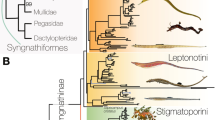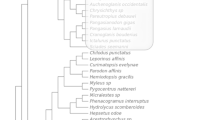Abstract
Under a nearly neutral model in which most amino acid substitutions are slightly deleterious, variation in demography, population structure, and other ecological factors among closely related species can potentially modify the effective population size or the selective regime, leading to differences in the rate of nonsynonymous substitution. Ratios of nonsynonymous to synonymous substitutions (dN/dS) between species were analyzed in a sea star genus (Patiriella) and a molluscan genus (Littorina), each with diverse modes of reproduction, including multiple lineages with pelagic and nonpelagic larvae. In both genera, lineages with nonpelagic larvae had significantly higher dN/dS ratios than lineages with pelagic larvae. The hypothesis that the elevated dN/dS ratios in species with nonpelagic larvae was due to reduced effective population size was tested by comparing nucleotide diversities in three genera of gastropod mollusks (Littorina, Crepidula, and Hydrobia), each with several modes of reproduction. Overall, there was a significant (p < 0.05) reduction in nucleotide diversity in species with nonpelagic larvae compared to species with pelagic larvae.


Similar content being viewed by others
References
A Arndt MJ Smith (1998) ArticleTitleGenetic diversity and population structure in two species of sea cucumber: Differing patterns according to mode of development. Mol Ecol 7 1053–1064 Occurrence Handle10.1046/j.1365-294x.1998.00429.x
A Arndt C Marquez P Lambert MJ Smith (1996) ArticleTitleMolecular phylogeny of eastern Pacific sea cucumbers (Echinodermata: Holothuroidea) based on mitochondrial DNA sequence. Mol Phylogenet Evol 6 425–437 Occurrence Handle10.1006/mpev.1996.0091 Occurrence Handle8975697
DJ Ayre TP Hughes (2000) ArticleTitleGenotypic diversity and gene flow in brooding and spawning corals along the Great Barrier Reef, Australia. Evolution 54 1590–1605 Occurrence Handle1:STN:280:DC%2BD3MzgsVOmug%3D%3D Occurrence Handle11108587
M Byrne A Cerra (1996) ArticleTitleEvolution of intragonadal development in the diminutive asterinid sea stars Patirella vivipara and P. parvivipara with an overview of development in the Asterinidae. Biol Bull 191 17–26
RJ Chambers CD McQuaid R Kirby (1998) ArticleTitleThe use of randomly amplified polymorphic DNA to analyze the genetic diversity, the systematic relationships and the evolution of intertidal limpets, Siphonaria spp. (Pulmonata: Gastropoda), with different reproductive modes. J Exp Mar Biol Ecol 227 49–66 Occurrence Handle10.1016/S0022-0981(97)00261-X Occurrence Handle1:CAS:528:DyaK1cXjt1Clurw%3D
AM Clark (1993) ArticleTitleAn index of names of recent Asteroidea. Part 2. Valvatida. Echin Stud 4 187–366
R Collin (2001) ArticleTitleThe effects of mode of development on phylogeography and population structure of North Atlantic Crepidula (Gastropoda: Calyptraeidae). Mol Ecol 10 2249–2262 Occurrence Handle10.1046/j.1365-294X.2001.01372.x Occurrence Handle1:STN:280:DC%2BD3MrgslWitA%3D%3D Occurrence Handle11555267
TF Duda SR Palumbi (1999) ArticleTitleDevelopmental shifts and species selection in gastropods. Proc Natl Acad Sci USA 96 10272–10277 Occurrence Handle10.1073/pnas.96.18.10272 Occurrence Handle1:CAS:528:DyaK1MXlvFens74%3D Occurrence Handle10468598
DJ Funk JJ Wernegreen NA Moran (2001) ArticleTitleIntraspecific variation in symbiont genomes: Bottlenecks and the aphid-Buchnera association. Genetics 157 477–489 Occurrence Handle1:CAS:528:DC%2BD3MXhtlyns7w%3D Occurrence Handle11156972
M Haase (1993) ArticleTitleThe genetic differentiation in three species of the genus Hydrobia and systematic implications (Caenogastropoda, Hydrobiidae). Malacologia 35 389–398
KA Hadfield BJ Swalla WR Jeffery (1995) ArticleTitleMultiple origins of anural development in ascidians inferred from rDNA sequences. J Mol Evol 40 413–427 Occurrence Handle1:CAS:528:DyaK2MXltVektr4%3D Occurrence Handle7646666
MW Hart M Byrne MJ Smith (1997) ArticleTitleMolecular phylogenetic analysis of life-history evolution in asterinid starfish. Evolution 51 1848–1861
M Hasegawa Y Cao Z Yang (1998) ArticleTitlePreponderance of slightly deleterious polymorphism in mitochondrial DNA: Nonsynonymous/synonymous rate ratio is much higher within species than between species. Mol Biol Evol 15 1499–1505 Occurrence Handle1:CAS:528:DyaK1cXntlOgs78%3D Occurrence Handle12572613
AL Hughes M Nei (1988) ArticleTitlePattern of nucleotide substitution at major histocompatibility complex class I loci reveals overdominant selection. Nature 335 167–170 Occurrence Handle3412472
A Hunt (1993) ArticleTitleEffects of contrasting patterns of larval dispersal on the genetic connectedness of local populations of two intertidal starfish, Patiriella calcar and P. exigua. Mar Ecol Prog Ser 92 179–186
KP Johnson J Seger (2001) ArticleTitleElevated rates of nonsynonymous evolution in island birds. Mol Biol Evol 18 874–881 Occurrence Handle1:CAS:528:DC%2BD3MXjtFykt7Y%3D Occurrence Handle11319271
S Kumar K Tamura IB Jakobsen M Nei (2001) ArticleTitleMEGA2: Molecular evolutionary genetics analysis software. Bioinformatics 17 1244–1245 Occurrence Handle1:CAS:528:DC%2BD38XmtVCktQ%3D%3D Occurrence Handle11751241
CJ Kyle EG Boulding (2000) ArticleTitleComparative population genetic structure of marine gastropods (Littorina spp.) with and without pelagic larval dispersal. Mar Biol 137 835–845 Occurrence Handle1:CAS:528:DC%2BD3MXkvFWmtQ%3D%3D
J Leebens-Mack C dePamphilis (2002) ArticleTitlePower analysis of tests for loss of selective constraint in cave crayfish and nonphotosynthetic plant lineages. Mol Biol Evol 19 1292–1302 Occurrence Handle1:CAS:528:DC%2BD38XmtF2rsr0%3D Occurrence Handle12140241
BS Lieberman WD Allmon N Eldredge (1993) ArticleTitleLevels of selection and macroevolutionary patterns in the turritellid gastropods. Paleobiology 19 205–215
CS McFadden R Donahue BK Hadland R Weston (2001) ArticleTitleA molecular phylogenetic analysis of reproductive trait evolution in the soft coral genus Alcyonium. Evolution 55 54–67 Occurrence Handle1:CAS:528:DC%2BD3MXhvFKksL0%3D Occurrence Handle11263746
D Ó Foighil DJ Taylor (2000) ArticleTitleEvolution of parental care and ovulation behavior in oysters. Mol Phylogenet Evol 15 301–313 Occurrence Handle10.1006/mpev.1999.0755 Occurrence Handle1:STN:280:DC%2BD3c3pvVGgtQ%3D%3D Occurrence Handle10837159
T Ohta (1992) ArticleTitleThe nearly neutral theory of molecular evolution. Annu Rev Ecol Syst 23 263–286 Occurrence Handle10.1146/annurev.es.23.110192.001403
PM O’Loughlin JM Waters MS Roy (2002) ArticleTitleDescription of a new species of Patiriella from New Zealand, and review of Patiriella regularis (Echinodermata, Asteroidea) based on morphological and molecular data. J Roy Soc NZ 32 697–711
JA Pechenik (1999) ArticleTitleOn the advantages and disadvantages of larval stages in benthic marine invertebrate life cycles. Mar Ecol Prog Ser 177 269–297
JS Porter JS Ryland GR Carvalho (2002) ArticleTitleMicro- and macrogeographic genetic structure in bryozoans with different larval strategies. J Exp Mar Biol Ecol 272 119–130 Occurrence Handle10.1016/S0022-0981(02)00042-4 Occurrence Handle1:CAS:528:DC%2BD38XlsVWlt70%3D
DM Rand (2001) ArticleTitleThe units of selection on mitochondrial DNA. Annu Rev Ecol Syst 32 415–448 Occurrence Handle10.1146/annurev.ecolsys.32.081501.114109
DG Reid (1990) ArticleTitleA cladistic phytogeny of the genus Littorina (Gastropoda): Implications for evolution of reproductive strategies and for classification. Hydrobiologia 193 1–19
DG Reid E Rumbak RH Thomas (1996) ArticleTitleDNA, morphology and fossils: Phylogeny and evolutionary rates of the gastropod genus Littorina. Phil Trans Roy Soc Lond 351B 877–895
SAS Institute, Inc. (1989) SAS/STAT user’s guide, version 6, 4th ed, Vol 2. SAS Institute, Inc., Cary, NC
MP Small E Gosling (2000) ArticleTitleGenetic structure and relationships in the snail species complex Littorina arcana Hannaford Ellis, L. compressa Jeffreys and L. saxatilis (Olivi) in the British Isles using SSCPs of cytochrome-b fragments. Heredity 84 692–701 Occurrence Handle10.1046/j.1365-2540.2000.00717.x Occurrence Handle1:CAS:528:DC%2BD3cXmsVSisLY%3D Occurrence Handle10886385
TA Spradling MS Hafner JW Demastes (2001) ArticleTitleDifferences in rate of cytochrome-b evolution among species of rodents. J Mammal 82 65–80
CS Wilding J Grahame PJ Mill (2000) ArticleTitleMitochondrial DNA Col haplotype variation in sibling species of rough periwinkles. Heredity 85 62–74 Occurrence Handle10.1046/j.1365-2540.2000.00718.x Occurrence Handle1:CAS:528:DC%2BD3cXmsFOgsbg%3D Occurrence Handle10971692
T Wilke GM Davis (2000) ArticleTitleInfraspecific mitochondrial sequence diversity in Hydrobia ulvae and Hydrobia ventrosa (Hydrobiiae: Rissooidea: Gastropoda): Do their different life histories affect biogeographic patterns and gene flow? Biol J Linn Soc 70 89–105
T Wilke E Rolan GM Davis (2000) ArticleTitleThe mudsnail genus Hydrobia s.s. in the northern Atlantic and western Mediterranean: A phylogenetic hypothesis. Mar Biol 137 827–833 Occurrence Handle10.1007/s002270000407
GA Wray (1996) ArticleTitleParallel evolution of nonfeeding larvae in echinoids. Syst Biol 45 308–322
Z Yang (1997) ArticleTitlePAML: A program package for phylogenetic analysis by maximum likelihood. Comput Appl Biosci 13 555–556 Occurrence Handle9367129
Z Yang (2001) Adaptive molecular evolution. DJ Balding M Bishop C Cannings (Eds) Handbook of statistical genetics. Wiley New York 327–350
Z Yang JP Bielawski (2000) ArticleTitleStatistical methods for detecting molecular adaptation. Trends Ecol Evol 15 496–503 Occurrence Handle10.1016/S0169-5347(00)01994-7 Occurrence Handle11114436
Author information
Authors and Affiliations
Corresponding author
Rights and permissions
About this article
Cite this article
Foltz, D.W. Invertebrate Species with Nonpelagic Larvae Have Elevated Levels of Nonsynonymous Substitutions and Reduced Nucleotide Diversities . J Mol Evol 57, 607–612 (2003). https://doi.org/10.1007/s00239-003-2495-5
Received:
Accepted:
Issue Date:
DOI: https://doi.org/10.1007/s00239-003-2495-5




